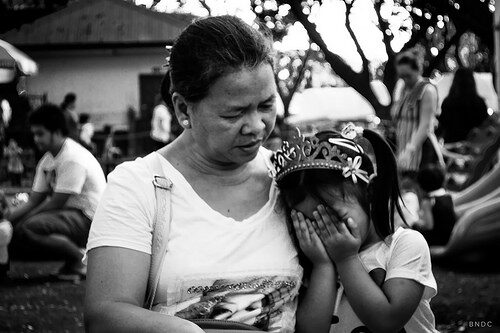There are good reasons why many autistic people avoid eye contact. And “when we look away, it doesn’t mean that we are not listening. We are not disrespecting you.”
The third row is one large panel. It is a close up of the eyes and nose of a white person with straight long purple hair and bangs, with eyes wide open. Black all-caps hand-lettered text on a white background at the top of the panel reads:
“If we try and make eye contact with people, it can totally distract us from what is being said because of how horrible it can feel and the effort involved.”
![[[image description & transcription: A full-color hand-drawn comic strip. The first row contains two panels. The left hand panel has a green background. A blond white person on the left is talking and maintaining eye contact with the olive-skinned person with long dark hair on the right. Black all-caps hand-lettered text on a white background above their heads reads: “For allistic people (non-autistic) eye contact is a way of connecting with others in conversation.” The right hand panel has a blue background. On the left A black person with a natural hairstyle is looking down, with an uncomfortable expression on their face while on the right a white person with long straight hot pink hair and bangs has their eyes closed tightly. Black all-caps hand-lettered text on a white background above their heads reads: “For autistic people, it’s different. Eye contact is uncomfortable and invasive.” The second row is a black rectangle with white hand-lettered all-caps text reading: “When we look away, it doesn’t mean that we are not listening. We are not disrespecting you.” The third row is one large panel. It is a close up of the eyes and nose of a white person with straight long purple hair and bangs, with eyes wide open. Black all-caps hand-lettered text on a white background at the top of the panel reads: “If we try and make eye contact with people, it can totally distract us from what is being said because of how horrible it can feel and the effort involved.” Red-outlined word bubbles around the edge of the panel, in black all-caps hand-lettered text on a white background, read: “Keep looking” “Having I looked too much?” “This hurts” “Am I doing this right?” “I have no idea what they’re saying” “Can’t do this” and “I feel so vulnerable” All caps hand-lettered black text under the panel reads: “© Beth Wilson 2017”]](https://thinkingautismguide.com/wp-content/uploads/2018/01/Eye-Contact-12B252812529-8906717.jpg)







